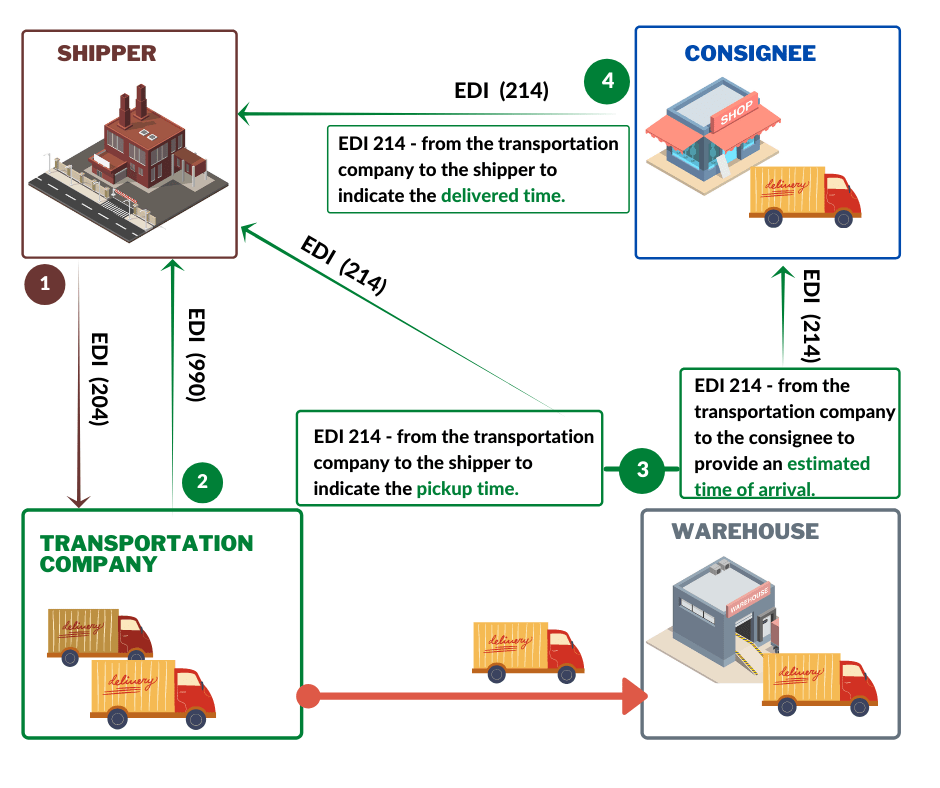We recently published a blog post on EDI (Electronic Data Interchange) for Specific Industries where we took a quick look at various industries and their use of EDI.
In this article, we will take a closer look at the use of EDI in transport logistics and especially in motor carrier freight transportation companies. In this article, we will review a list of the most used EDI documents in the transportation industry. We will examine what each EDI document is used for and what benefits EDI provides to transportation and shipping companies and their clients.
EDI for Transportation and Logistics Management
Transport logistics is accompanied by a constant “paperwork” associated with the movement of goods. Many participants are involved in this process such as manufacturers of goods, warehouses, carriers, retailers, etc.
For efficient logistics, it is necessary to automate communication between all participants of the logistics process: carriers, shippers, consignees, freight customers, and a freight broker. The use of EDI for automatic data exchange is the most effective technological solution to overcome such a challenge.
Advantages of Using Electronic Data Interchange (EDI) in Transportation
EDI has changed the way business partners interact and optimized the business processes of the supply chain. Using EDI, companies can effectively manage document flow at all stages of working with business partners: from ordering and receiving at the warehouse to reconciliation and returns. You can send orders, invoices, and other documents without paperwork and efforts duplication.
- Transport optimization. EDI helps to optimize and consolidate shipments from different customers.
- Prompt document exchange. EDI allows you to instantly exchange important shipping documents with your business partners, saving both parties time and resources.
- Labor Cost optimization. EDI allows you to automate daily routine operations related to entering data into ERP, CRM, TMS, WMS, or accounting systems, processing, sending, and archiving documents. Thus, by automating the processing of documents using EDI, there is no need to manually verify documents, enter data, and perform other repetitive actions that take a lot of time.
- Seamless integration of EDI with other business systems within a company.
- Synchronization of data exchange between EDI and business systems improves all stages of the supply chain in a transport company and eliminates the inefficient use of resources.
The Most Commonly used EDI Documents in the Transportation Industry
Let’s look at the most used EDI document in more detail.
EDI 204 Transaction Set: Motor Carrier Load Tender
What is a 204 Tender?
The EDI X12 204 Motor Carrier Load Tender, is an electronic document sent by the shipper (a manufacturer, a retailer, or a distribution center or wholesalers) to the freight carrier company to present an offer for an FTL shipment.
The term FTL Full Truck Load describes a mode of transportation that consists of at least one complete cargo trailer or does not allow other loads to be transported simultaneously.
Key Information of EDI 204 Motor Carrier Load Tender
EDI 204 Motor Carrier Load Tender contains important shipment information including:
- Product description, including weight, size, and quantity.
- The size of the required trailer as well as other requirements for equipment if necessary to arrange transportation.
- delivery schedule
- pickup and drop destination,
- Information about consignees (delivery address and contact details)
Why Use EDI 204 for Load Tender?
Load tendering is a bidding process where customers offer equal opportunity to transportation companies and carriers to submit their pricing and bid on the transportation of goods, based on pre-defined criteria and parameters. The carriers can accept or reject the shipper’s offer.
Using EDI 204 to tender among transport companies is a common practice. It helps ensure contract compliance and automates payments to carriers. In addition, the use of EDI provides detailed information throughout the entire delivery process from loading to delivering the goods to its final destination.
If you want to know more about EDI X12 204 read this article: EDI X12 204 Motor Carrier Load Tender – overview
EDI 990 Transaction Set: Response to a Load Tender
What is an EDI 990 Response to a Load Tender?
EDI 990 is a response to an EDI 204 Motor Carrier Load Tender sent by transportation companies to a shipper. EDI 990 can be used to accept, accepted with conditions, or reject a load tender (EDI 204).
What is Important to Know About EDI 990
Typically, an EDI 990 is required for each incoming EDI 204 to accept or reject a load request. Therefore, most often these two EDI documents are implemented in the transport company at once.
When working with documents such as the 204 and 990, time is critical. The business partners usually agree on how long after receipt of the EDI 204, the transport company must respond with an EDI 990 before the contract is transferred to another carrier.
Useful reading: EDI for Third-Party Logistics providers (3PL)
EDI 214 Transaction Set: Transportation Carrier Shipment Status Message
What is EDI 214 Transportation Carrier Shipment Status Message?
The transportation company sends an EDI 214 to the shipper to provide information on the delivery status. Typically, an EDI 214 contains information about the status of the shipment, place of delivery, estimated time of arrival, route Information, description of shipment – weight, packaging, and quantity.
Depending on the preliminary agreements of business partners, as well as the specifics of the business, EDI 214 can be generated and transferred to the shipper from once a week to 6 times a day.
Who Uses EDI 214?
Document EDI 214 is widely used in transport logistics and especially in international deliveries.
The largest transport companies, such as FedEx Freight, Old Dominion Freight Line, DHL Supply Chain & Global Forwarding, and much more use the Transportation Carrier Shipment Status Message (EDI 214) to convey the delivery status to the shipper.
To find out more useful information about EDI 214 and learn how to start exchanging EDI 214 in an hour or less, please read this article: EDI for transportation – EDI 214 Transportation Carrier Shipment Status Message
EDI 210 Transaction Set: Motor Carrier Freight Details and Invoice
What is an EDI 210?
EDI 210 is an electronic document sent by the carrier to the shipper to provide detailed information related to the cost of transportation services. This EDI document can be used as an invoice to request payment for motor freight transportation or to provide information about the transportation fees.
What Data Does the EDI X12 210 Transmit?
The EDI 210 contains standard invoice information such as the number and date of the invoice, address of the consignee and the shipper, information about the product (name, quantity, weight, and size), billing information, as well as motor carrier expense details, delivery methods, and route information.
Useful reading: All You Need to Know about EDI 210 – Motor Carrier Freight Details and Invoice
Digital Transformation of the Logistics Business with EDI
Our company helps logistics companies in their digital transformation. Our advanced EDI solutions drive business growth by improving business processes and reducing labor costs for document and data management.
Contact us for a free consultation with one of our EDI experts.








